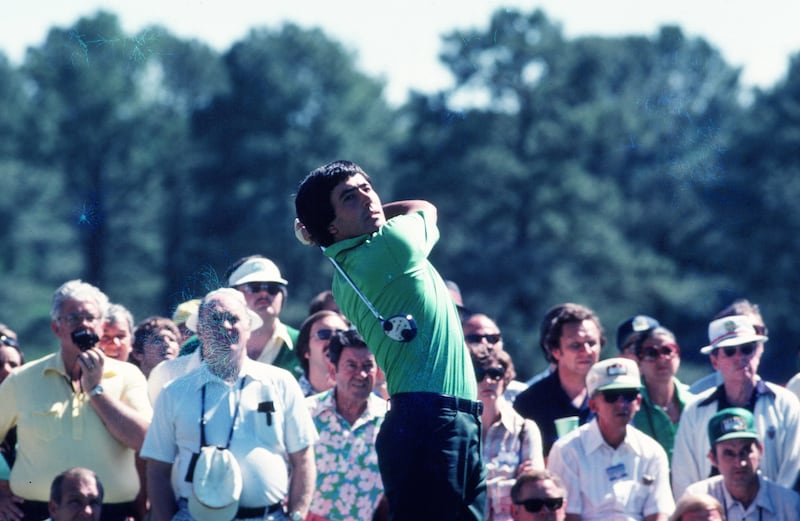Even the Green Jackets at Augusta, still reeling from the American civil war, are actors in the worldwide “content” war. After each round of the Masters bespoke highlights packages were released online, including one simply called, “Longest Drives.” It must have been approved by an algorithm.
On Day Two most of the drives in the package were on the 9th, a dog-leg par four with a down-sloping fairway. At the bottom of the hill is a spectator crossing that has been in the same spot for as long as anybody can remember. In recent years a sprinkling of drives may have reached that far, but it wasn’t a feature of the television coverage; this year, it was a daily staple.
Matt Fitzpatrick, not one of the longest drivers in the game, launched a ball that travelled 382 yards, stopping only when it kissed the ankle of a punter on the spectator crossing. On the same day, Bryson de Chambeau, the Frankenstein of long driving, hit a tee shot that was clocked at 420 yards until it met the upslope, and doubled back; it came to rest at 387. By then, it had traversed the spectator crossing twice — coming and going.
In golf’s agonising about long-hitting the spectator crossing on the ninth hole at Augusta National is a very small frontier. It was only interesting as a new way to illustrate the story. At a golf tournament intoxicated with control, and managing its image, the subversive attack on a spectator crossing by ballistic tee shots was out of their control. They could dye the water blue and paint the grass green, but they couldn’t defend the crossing.
READ MORE
One of the recurring arguments in the debate about the golf ball is that venerable old courses are having their dignity vandalised by the pros. In the Majors, this is especially true in the rota of British Open courses but Augusta has also suffered.
For the first 70 years of its existence, the length of the course for the Masters was unchanged at 6,900 yards; this year it was nearly 7,600 yards. “Adding distance to Augusta National golf course has become a standard operation for the last two decades,” said club chairman Fred Ridley in his annual press conference at the tournament.
He said that he never wanted to see the Masters played on an 8,000-yard golf course but was afraid that it was likely to happen, “in the not-too-distant”.

So, what’s in it for us, the audience? Have we become so anaesthetised to the numbers flashing up on our television screens that bazooka-style driving is hardly even a spectacle now? At what point did the wonder die?
Remember when it was still a sensation? Augusta was a canvas for that too. When Seve Ballesteros won his first Masters in 1979, as a swashbuckling 23-year-old, he reached the par 5 15th with a drive and a four iron. In the commentary, you can hear the exclamation marks.
“Can you believe it? He hit the drive well over 300 yards!”
When Tiger Woods won his first Masters in 1997 he reduced the same hole to a drive and a wedge. And of all the sensations he caused that week, his humbling of the 15th is still quoted now. When was the last time a long drive was burned into your memory? You can’t remember?
In that same year, John Daly became the first player to average more than 300 yards in a PGA Tour season and at the time there was an element of the four-minute mile about his achievement. A boundary had been breached and others were sure to scamper through the opening.
This year on the PGA Tour, 65 players are averaging more than 300 yards. Scottie Scheffler, though — the Masters Champion and the best player in the world — strangely isn’t one of them. In the driving statistics, he stands at number 76, his average having dropped 10 yards since last year. At the Masters Scheffler ended up 13th in driving distance, but in rounds one and two his average was significantly below 300 yards.
One of the hackneyed assertions about professional golf now is that you can’t compete unless you can hit the ball a mile and that must be true. Yet, season after season, many of the players who populate the top of the longest-drive statistics rarely appear on PGA Tour leaderboards.

Alongside Rory McIlroy in the top five at the moment are Cameron Champ, Chris Gotterup, Kevin Dougherty and Carl Yuan. Elsewhere in the top 10 you’ll find Alejandro Tosti, Vincent Norrman and Taylor Pendrith; Joseph Bramlett is bubbling under, as they used to say on Top of the Pops. Stop me if you see a star.
After years of prevaricating the R&A and USGA finally decided on “golf ball roll back” last December. The changes will come into effect in January 2028 and it is expected that the average male professional will lose nine to 11 yards of distance.
How long before they gain that distance back? Not long. What then? More tinkering. Another rollback. More agonising.
The makers of golf equipment need their poster-boy professionals to thrash the ball long distances to flog their wares to millions of club golfers worldwide who are desperate to hit the ball just a little further.
The PGA Tour and their broadcast partners in America, who have been fighting a rearguard action on audience numbers for years, don’t want to take the driver out of the top players’ hands. They don’t want tournament courses set up in such a fashion that playing for position off the tee with low-risk shots becomes the only prudent course of action. They want the steak and the sizzle.
Is that possible? Last week’s PGA Tour stop was a perfect example. Hilton Head is about 400 yards shorter than Augusta, but the fairways are not wide and the course is defined by towering trees that invade the players’ eye-lines. On top of that, there is an abundance of dog legs. There are still plenty of holes where the players must take driver off the tee, but the premium is on accuracy and strategy and scrambling and being able to shape the ball.
Maybe you prefer the sizzle. I prefer golf.

















